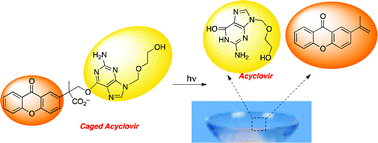We have attached the antiviral drug acyclovir (ACV) to a xanthone photolabile protecting group (or photocage) through the O6 position of acyclovir, a procedure designed for the treatment of ocular herpes simplex virus infections. Acyclovir is photoreleased from the photocage, under physiological conditions, with a quantum yield (ΦACV release) of 0.1–0.3 and an uncaging cross section (Φ·ε) of 450–1350 M cm−1. We demonstrate that this photorelease method outcompetes alternative reaction pathways, such as protonation. Furthermore, complete release of the drug is theoretically possible given a sufficient dose of light . Surprisingly the acyclovir photocage, also showed some antiviral activity towards HSV-1.
You have access to this article
 Please wait while we load your content...
Something went wrong. Try again?
Please wait while we load your content...
Something went wrong. Try again?


 Please wait while we load your content...
Please wait while we load your content...